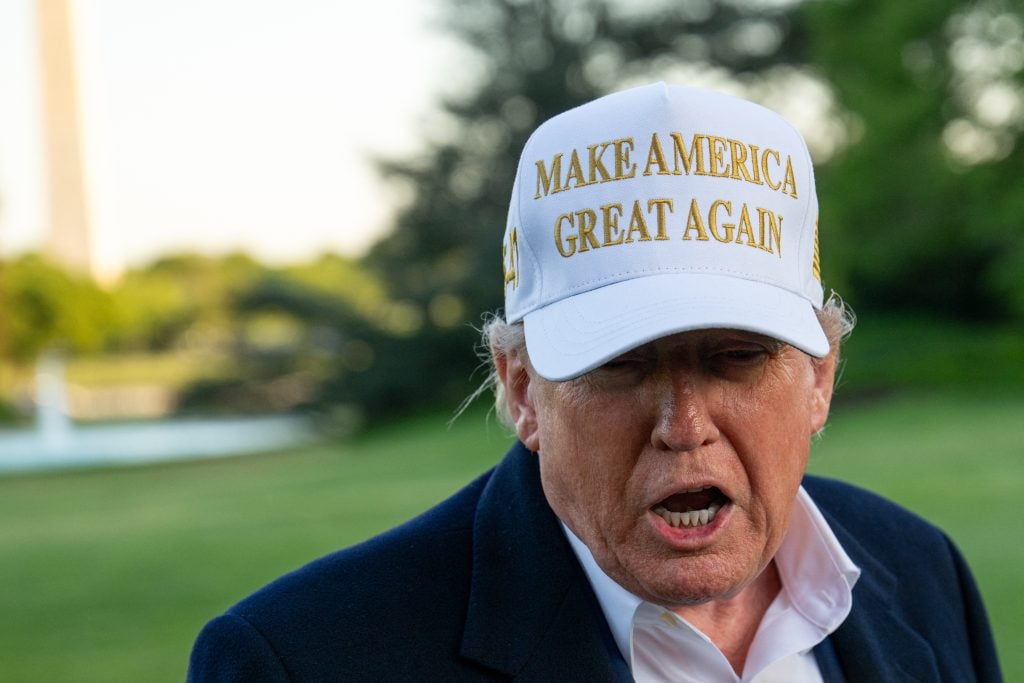US President Donald Trump has made no secret of his fondness for tariffs – which he has frequently taken to branding “the most beautiful word in the dictionary.”
It therefore could have come as no surprise to markets and policymakers when, speaking from the White House at the start of April, the President announced his “Liberation Day” measures imposing sweeping tariffs on countries around the world.
However, one might be forgiven for being surprised at the country which was singled out for especially harsh treatment: the tiny African nation of Lesotho. Lesotho, which primarily exports diamonds and clothing, received the highest “Liberation Day” tariff of 50%.
Trump’s tariffs were calculated by taking the US’ trade deficit with each country, and then dividing that number by the total value of imports from that nation; almost all countries face a blanket minimum of 10%. Poorer nations such as Lesotho, which exports around $55m worth of diamonds annually to the US but imports barely anything, were therefore found to be the “worst offenders.”
Madagascar, which exports relatively modest amounts of vanilla and clothing to the US while importing very little, was similarly condemned under this calculation. The East African island was hit with a tariff of 47% as a result of the perceived trade disparity.
“Large and persistent annual US goods trade deficits have led to the hollowing out of our manufacturing base, inhibited our ability to scale advanced domestic manufacturing capacity, undermined critical supply chains, and rendered our defence-industrial base dependent on foreign adversaries,” according to an executive order issued by the President seeking to explain the thinking behind this move.
“Large and persistent annual US goods trade deficits are caused in substantial part by a lack of reciprocity in our bilateral trade relationships.”
Backtrack brings temporary respite
There has been some respite for Lesotho, Madagascar, and every other country facing steep tariffs. The week after “Liberation Day,” Trump temporarily backtracked by announcing there would be a ninety-day pause for all countries, during which time only the universal 10% baseline tariff would apply.
This is with the exception of China, which, thanks to a series of retaliations and counterretaliations, at the time of writing faces tariffs of 145% on most of its exports to the US. American firms exporting to China have been hit with a slightly lower rate of 125%. However, African governments, policymakers, and business leaders are still grappling with the fallout – and trying to assess what the long-term consequences for the continent could be.
Daniel Silke, a political economy analyst based in Cape Town, tells African Business that “the on-off tariff threats have unleashed uncertainty in markets across the world.”
“It is an old cliché, but it remains correct: markets do not like uncertainty, whether in the major capitals of the world, or in developing countries,” he says.
Cheta Nwanze, founder of Lagos-based geopolitical research firm SBM Intelligence, is relatively optimistic that the impact of tariffs will be limited on Africa’s real economy – but agrees that the uncertainty and market disruption could affect investor sentiment and therefore dent capital flows into the continent.
“For many African countries, the informal sector is huge. In Nigeria for example, the oil sector accounts for about 90% of government revenue but only about 6% of GDP. The entire oil industry employs fewer than 100,000 people in a country of 200 million,” he explains.
Nwanze says these dynamics create a “dissonance” where sectors highly vulnerable to global markets and geopolitical events “create an outsized amount of noise” on issues such as tariffs, which do not always directly impact the much larger informal economy.
He points out that “from an African point of view, the US trade disappearing does not have too much of a real effect because, with the possible exception of Djibouti, every African country trades more with China than the US.”
Africa exposed to trade war
While the direct economic impact of tariffs on African countries may be limited in this sense, there is a risk that the continent could be exposed to the consequences of the escalating trade war between Washington DC and Beijing.
The drop in trade between the world’s two largest economies is likely to be enormous: the World Trade Organization projects an 80% decline in US-China merchandise trade in 2025. The International Monetary Fund (IMF) has previously warned that Sub-Saharan Africa could be the region worst impacted by “geoeconomic fragmentation” resulting from trade barriers imposed between East and West.

Nwanze is confident that Chinese demand for African goods and resources will stay strong despite the potential damage tariffs will cause to its economy. “China has been preparing for this for quite a while: the Belt and Road Initiative can be seen as “geostrategic preparation” through which China has strengthened its internal market while creating new external markets,” he says.
However, Silke is more concerned about African economies being caught in the crossfire. In particular, he believes the steep drop in goods trade between the US and China is likely to create a large surplus of Chinese goods on the market – something that could potentially undercut African producers.
“I think that there will be a lot of products available from China as a result of these tariffs. Chinese goods will no longer go to the United States; they will likely be offloaded to developing markets and sold at relatively cheap prices,” Silke tells African Business.
“This is a threat to African manufacturing, which cannot compete at these levels. It puts a brake on Africa’s ability to produce basic goods and services at affordable prices as it will be difficult to compete with the low prices coming out of China.”
Silke also fears that the political fallout from US-China tensions will potentially force African countries to pick a side – undermining efforts through initiatives such as the African Continental Free Trade Area (AfCFTA) to harmonise trading regulations and promote intra-African trade.
“This really places African countries in a very awkward position. Some will feel as though they can deal more satisfactorily with Washington, some will feel as though they want to move closer to China,” he says.
“This will pose difficulties for a continent which is trying to find commonality when it comes to trade regulations. Those countries that move closer to China will be in a different orbit to those countries that engage in closer trade ties with Washington,” Silke adds. “This could break the idea of the more united trading bloc that Africa can and probably should become.”
Dollar depreciation?
The impact of Trump’s tariffs on foreign exchange markets could also have an impact on African economies. The dollar initially soared against emerging market currencies after Trump’s election win in November as markets predicted tariffs would increase inflation in the States, forcing the Federal Reserve to keep interest rates higher and therefore feeding into a stronger dollar.
However, most analysts now expect that the disruption caused by the imposition of tariffs could lead to the depreciation of the US dollar. The global investment bank Goldman Sachs, for example, has suggested the dollar will weaken by as much as 10% against other major currencies as a result of slowing GDP growth and reduced investor confidence in the States.
Silke notes that “I would expect the dollar to weaken – investors will be hesitant to invest in the United States as a result of the volatility we have seen and the uncertainty as to how tariffs are being applied. I do not think this is good for domestic US business and therefore I think that we will see pressure on the US dollar going forward.”
He adds that a weaker dollar would “provide a modicum of improvement to African economies,” given imports priced in dollars would become relatively cheaper and therefore reduce inflationary pressures. However, these gains would be dependent “on African economies [achieving] a level of domestic political stability in order to maintain decent values for their own domestic currencies.”
A greater risk for African countries potentially comes from moves in bond markets. Yields on both ten and thirty-year US Treasury bonds went up significantly in the days after the tariff announcement, with the yield for thirty-year treasuries currently standing at 4.87% in late April – an almost 25% rise compared to September last year. Silke says this means “borrowing costs could well become more onerous, certainly for the United States, but potentially for other parts of the world as well.”
Nwanze adds that an environment of higher interest rates in the US, which is likely as a result of the inflationary pressures caused by the imposition of tariffs, would “definitely have a negative impact on African countries which have been taking on bigger and bigger amounts of dollar-denominated debt.”
Much continues to remain uncertain as to what Trump plans to do on trade in the coming months. What seems more evident, as Silke and Nwanze both say, is that the Africa Growth and Opportunity Act (AGOA) – a US government programme which allows eligible African countries duty-free access to the American market – is dead.
It is difficult to forecast, especially in these early days, exactly how much damage will be done to African economies as a result of escalating trade tensions. But as Silke points out, the fracturing of the global trading environment will “have a negative effect on the broader global economy.”
“The cloud of recession hangs over everyone, everywhere – and Africa certainly does not escape that.”
Crédito: Link de origem


